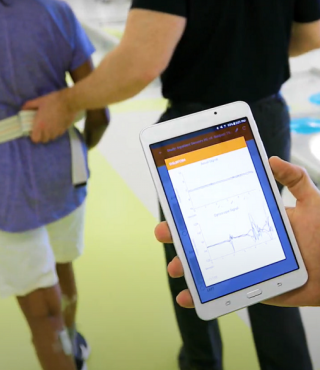Purpose
The FAC assesses functional ambulation in patients undergoing physical therapy.
Acronym
FAC
Area of Assessment
Functional Mobility
Gait
Assessment Type
Observer
Administration Mode
Paper & Pencil
Cost
Free
Diagnosis/Conditions
- Multiple Sclerosis
- Stroke Recovery
- Clinician-completed tick box of 5 broad categories of walking ability.
- Ranges from independent walking outside to non-functional walking.
- Patients can be rated on the following categories:
0) Patient cannot walk, or needs help from 2 or more persons
1) Patients needs firm continuous support from 1 person who helps carrying weight and with balance
2) Patient needs continuous or intermittent support of one person to help with balance and coordination
3) Patient requires verbal supervision or stand-by help from one person without physical contact
4) Patient can walk independently on level ground, but requires help on stairs, slopes or uneven surfaces
5) Patient can walk independently anywhere
Required Training
No Training
Instrument Reviewers
Initially reviewed by the Rehabilitation Measures Team; Updated with references from the TBI population by Katie Hays, PT, DPT and the TBI EDGE task force of the Neurology Section of the APTA in 2012.
ICF Domain
Activity
Measurement Domain
Motor
Professional Association Recommendation
Recommendations for use of the instrument from the Neurology Section of the American Physical Therapy Association’s Multiple Sclerosis Taskforce (MSEDGE), Parkinson’s Taskforce (PD EDGE), Spinal Cord Injury Taskforce (PD EDGE), Stroke Taskforce (StrokEDGE), Traumatic Brain Injury Taskforce (TBI EDGE), and Vestibular Taskforce (Vestibular EDGE) are listed below. These recommendations were developed by a panel of research and clinical experts using a modified Delphi process.
For detailed information about how recommendations were made, please visit: http://www.neuropt.org/go/healthcare-professionals/neurology-section-outcome-measures-recommendations
|
Abbreviations:
|
|
|
HR
|
Highly Recommend
|
|
R
|
Recommend
|
|
LS / UR
|
Reasonable to use, but limited study in target group / Unable to Recommend
|
|
NR
|
Not Recommended
|
Recommendations for use based on acuity level of the patient:
|
|
Acute
(CVA < 2 months post)
(SCI < 1 month post)
(Vestibular < 6 weeks post)
|
Subacute
(CVA 2 to 6 months)
(SCI 3 to 6 months)
|
Chronic
(> 6 months)
|
|
StrokEDGE
|
R
|
UR
|
UR
|
Recommendations based on level of care in which the assessment is taken:
|
|
Acute Care
|
Inpatient Rehabilitation
|
Skilled Nursing Facility
|
Outpatient
Rehabilitation
|
Home Health
|
|
StrokEDGE
|
UR
|
R
|
UR
|
UR
|
UR
|
|
TBI EDGE
|
LS
|
LS
|
LS
|
LS
|
LS
|
Recommendations for use based on ambulatory status after brain injury:
|
|
Completely Independent
|
Mildly dependant
|
Moderately Dependant
|
Severely Dependant
|
|
TBI EDGE
|
NR
|
LS
|
LS
|
NR
|
Recommendations for entry-level physical therapy education and use in research:
|
|
Students should learn to administer this tool? (Y/N)
|
Students should be exposed to tool? (Y/N)
|
Appropriate for use in intervention research studies? (Y/N)
|
Is additional research warranted for this tool (Y/N)
|
|
StrokEDGE
|
No
|
No
|
No
|
Not reported
|
|
TBI EDGE
|
No
|
Yes
|
No
|
Not reported
|
Considerations
Tested primarily in stroke population:
(Kollen et al, 2006): FAC scores depend on the timing of comfortable walking speed measurements after stroke
Do you see an error or have a suggestion for this instrument summary? Please e-mail us!


